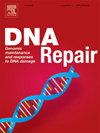Unveiling cGAS mechanisms: Insights into DNA damage and immune sensing in cancer
IF 2.7
3区 生物学
Q2 GENETICS & HEREDITY
引用次数: 0
Abstract
The innate immune sensing system plays a critical role in recognizing and responding to DNA damage, which is a key factor in cancer development and progression. The cyclic GMP-AMP synthase-stimulator of interferon genes (cGAS-STING) pathway, in particular, detects cytosolic double-stranded DNA (dsDNA) and activates the innate immune response. Recent studies have shown that cGAS is sequestered on chromatin by binding to the acidic patch (AP) regions of histones. Upon DNA damage, its ability to bind to chromatin-associated dsDNA fragments requires the DNA damage sensor MRE11. Upon its activation, cGAS triggers an innate immune response that can suppress tumorigenesis. However, the context-specific factors that govern whether cGAS engagement leads to effective STING pathway activation remain incompletely defined, particularly in relation to chromatin context, micronuclear integrity, and post-translational modifications. In this review, we explore the dynamic interplay between DNA damage responses and innate immune signaling through the cGAS-STING axis, with a focus on recent mechanistic advances. We further examine how cancers evade or co-opt this pathway and highlight therapeutic opportunities to exploit cGAS-STING signaling for cancer treatment.
揭示cGAS机制:对癌症中DNA损伤和免疫感知的见解
先天免疫感知系统在识别和响应DNA损伤中起着至关重要的作用,这是癌症发生和发展的关键因素。特别是环GMP-AMP合成酶刺激干扰素基因(cGAS-STING)途径,检测胞质双链DNA (dsDNA)并激活先天免疫反应。最近的研究表明,cGAS通过与组蛋白的酸性斑块(AP)区域结合而被隔离在染色质上。在DNA损伤时,其结合染色质相关的dsDNA片段的能力需要DNA损伤传感器MRE11。一旦被激活,cGAS就会触发先天免疫反应,从而抑制肿瘤的发生。然而,控制cGAS参与是否导致STING通路有效激活的环境特异性因素仍然不完全确定,特别是与染色质背景、微核完整性和翻译后修饰有关。在这篇综述中,我们通过cGAS-STING轴探讨了DNA损伤反应和先天免疫信号之间的动态相互作用,并重点介绍了最近的机制进展。我们进一步研究了癌症如何逃避或利用这一途径,并强调了利用cGAS-STING信号进行癌症治疗的治疗机会。
本文章由计算机程序翻译,如有差异,请以英文原文为准。
求助全文
约1分钟内获得全文
求助全文
来源期刊

DNA Repair
生物-毒理学
CiteScore
7.60
自引率
5.30%
发文量
91
审稿时长
59 days
期刊介绍:
DNA Repair provides a forum for the comprehensive coverage of DNA repair and cellular responses to DNA damage. The journal publishes original observations on genetic, cellular, biochemical, structural and molecular aspects of DNA repair, mutagenesis, cell cycle regulation, apoptosis and other biological responses in cells exposed to genomic insult, as well as their relationship to human disease.
DNA Repair publishes full-length research articles, brief reports on research, and reviews. The journal welcomes articles describing databases, methods and new technologies supporting research on DNA repair and responses to DNA damage. Letters to the Editor, hot topics and classics in DNA repair, historical reflections, book reviews and meeting reports also will be considered for publication.
 求助内容:
求助内容: 应助结果提醒方式:
应助结果提醒方式:


